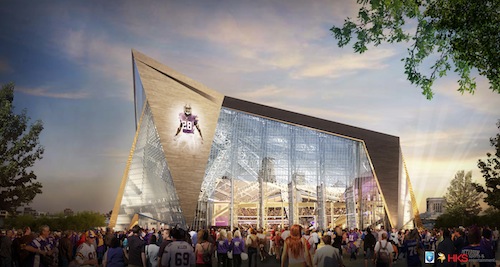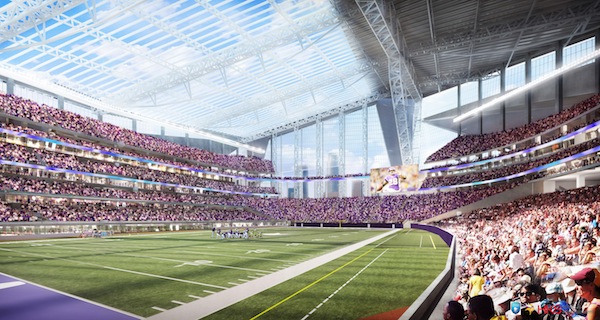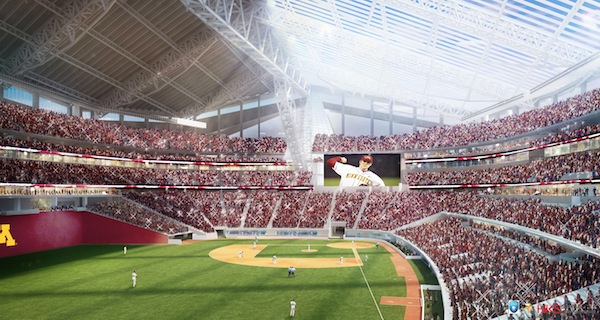The Minnesota Sports Facilities Authority (MSFA), the Minnesota Vikings and HKS Sports & Entertainment Group have unveiled the design of the State’s new multipurpose stadium in Minneapolis, a major milestone in getting the $975 million stadium built on time and on budget.The design package will now be submitted to the Minneapolis Stadium Implementation Committee and the City of Minneapolis for review.
Described as an authentic structure influenced by its Minnesota location, the new stadium exhibits a bold, progressive design that combines efficient functionality with stunning architecture. With a soaring prow, the largest transparent roof in the world, and operable doors that open to the downtown skyline, the facility’s openness and sleek geometric exterior will make it unlike any other stadium in the country.
“The design reflects the true story of the Minnesota community with its international style driven by climatic response and energy conservation,” said Bryan Trubey, design principal, HKS Sports & Entertainment Group. “The interior volume makes it the most versatile, multi?use building in the country with the most advanced digital age technology.”
Throughout the design process, HKS identified four major influencers that shaped the functional form and architecture of the building: climate, geography, history of important civic structures and technology. The recent pattern of modern and progressive physical form in Minnesota will continue with this facility, beginning with the roof. With ethylene tetrafluoroethylene (ETFE) on the roof’s southern half, visitors will feel as if they are sitting outside without being exposed to the elements. Sustainable characteristics will be utilized to produce lower operating costs in winter and summer, and the stadium’s sloped roof will be the most efficient roof structure in the nation, a remarkable engineering feat considering the snow?loading requirements with Minnesota’s climate.
The new stadium will be capable of hosting more events than any other large stadium in the world. Despite its versatility, the stadium’s football configuration puts the fans closer to the field than in any other NFL stadium.
“Tonight’s unveiling showcases a bold, iconic design delivered by HKS,” said Vikings Owner/President Mark Wilf. “Not only is this facility unique to Minnesota, but the stadium will also provide Vikings fans with the best game?day experience in the NFL, which has always been our goal.”
“Vikings fans will be closer to the action than any stadium in the country,” said Vikings Owner/Chairman Zygi Wilf. “The combination of operable end walls with a clear roof and large windows throughout the facility will give fans the opportunity to experience the best of both worlds: an outdoor feel with protection from the elements.”
Just as important as the experience for all users of the stadium is the building’s impact on the surrounding neighborhoods. Following Monday’s design presentation, the MSFA voted unanimously to approve the design and submit the details of the stadium to the Minneapolis Stadium Implementation Committee and the City of Minneapolis for review.
“We wanted a design that encourages a connection into the neighborhoods, that will spur economic development and that will act as a destination rather than a barrier,” said Michele Kelm?Helgen, Chair of the Minnesota Sports Facilities Authority. “The design, the amount of glass and light and the transparency makes this an iconic building that will attract a Super Bowl, NCAA basketball and baseball tournaments, world class concerts and other great events. The benefits to the state’s economy will be incredible.”
Groundbreaking for the new 65,000?seat stadium will take place in October 2013, and demolition of the Metrodome will begin early in 2014. The new stadium is scheduled to be open in time for the Vikings 2016 season.
“We look forward to bringing this wonderful design to life and beginning construction in a few short months,” said John Wood, senior vice president at Mortenson Construction, the stadium builder. “This stadium will be built for Minnesota by Minnesotans, and it will create an estimated 7,500 construction? related jobs and deliver substantial business opportunities for hundreds of local subcontractors and suppliers.”
The Building Team also includes engineer Thornton Tomasetti and construction manager Mortenson.
Facility facts at a glance:
-
Approximately 1.6 million square feet.
-
65,000 seats, including some of the closest in the NFL; expandable to 73,000 for a Super Bowl.
-
Up to 125 suites and 7,500 club seats, including suites and clubs at the field level, some of which will put fans closer to the sideline than in any other NFL stadium.
-
Seven levels, including two general admission concourses with 360?degree circulation and various views into the bowl.
-
Highest quality HD video boards in the NFL located in both the east and west end zones and video ribbon boards throughout the interior of the seating bowl.
-
Over 1,200 HD flat screen televisions throughout the concourse for all fans in attendance to view the game.
-
Capability to host more events than any other large stadium in the world, including NFL football and a Super Bowl, MLS soccer, NCAA basketball and baseball, high school sporting events, motocross, concerts, conventions, marching band competitions.
-
Access points to the city and stadium site from all four sides of the stadium.
-
Large west plaza (over two acres in size) for game day, non?game day and seasonal public gatherings as a connection to the downtown corridor.
-
Lightest and most efficient roof structure in the nation for a major new stadium, which will include a single large steel super truss providing primary support for the main long span roof.
-
Largest clear ethylene tetrafluoroethylene (ETFE) roof in the world and the first on a stadium in the nation, allowing connection to the outdoors from a climate?controlled environment.
-
Largest glass pivoting doors in the world that will open to the west plaza.
-
Application for LEED?certified status.
-
Parking ramps with skyways from the north and south sides of the stadium and connections from the facility to the downtown skyway system.
(http://www.vikings.com/news/article-1/Vikings-MSFA-and-HKS-Group-Unveil-New-Multi-Purpose-Stadium-Design/a22f251d-0e66-4c42-aab3-a32269114660)
Related Stories
| Aug 11, 2010
29 Great Solutions for the AEC Industry
AEC firms are hotbeds of invention and innovation to meet client needs in today's highly competitive environment. The editors of Building Design+Construction are pleased to present 29 "Great Solutions" to some of the most complex problems and issues facing Building Teams today. Our solutions cover eight key areas: Design, BIM + IT, Collaboration, Healthcare, Products, Technology, Business Management, and Green Building.
| Aug 11, 2010
Permanent tribute to Daniel Burnham and his Plan of Chicago proposed for Grant Park Museum Campus
The first-place winner of a design competition for a public memorial celebrating Daniel Burnham's impact on Chicago will be announced at a news conference Wednesday, July 8, at 10am CDT. The proposed site for the memorial is on the Museum Campus just north of The Field Museum. The announcement comes after nearly two years of planning by Chicago's architecture, design and urban planning community about how to best honor the legacy of Burnham and the Plan of Chicago he co-wrote with Edward Bennett.
| Aug 11, 2010
Arup, SOM top BD+C's ranking of the country's largest mixed-use design firms
A ranking of the Top 75 Mixed-Use Design Firms based on Building Design+Construction's 2009 Giants 300 survey. For more Giants 300 rankings, visit http://www.BDCnetwork.com/Giants
| Aug 11, 2010
Architecture billings index takes turn for the worse
After showing signs of stabilization over the last three months, the Architecture Billings Index (ABI) plunged nearly five points in June. As a leading economic indicator of construction activity, the ABI reflects the approximate nine to twelve month lag time between architecture billings and construction spending. The American Institute of Architects (AIA) reported the June ABI rating was 37.7, far lower than the 42.9 the previous month.
| Aug 11, 2010
International Living Building Institute established to advance 'living buildings'
The idea of a Living Building, a high-performance building that produces its own power and cleans and reuses all of its water, is gaining momentum around the world. In an effort to oversee the global development of Living Buildings, the International Living Building Institute (ILBI) has been established.
| Aug 11, 2010
Populous selected to design 'crystalline skin' stadium for 2014 Winter Olympics
Russian officials have selected global architect Populous to design the main stadium for the 2014 Winter Olympic and Paralympic Games in Sochi, Russia. The 40,000-seat stadium will feature a crystalline skin that "engages with its surroundings by day and provides an iconic representation of the color and spectacle of the games when illuminated at night," said Populous senior principal John Barrow.
| Aug 11, 2010
M&A deal volume down 67% in engineering/construction sector: PricewaterhouseCoopers
Global Economic Uncertainty Results in Sluggish Deal Activity in U.S.; China Shows Significant Opportunity for Growth
| Aug 11, 2010
Three Opus Corporation companies file for bankruptcy
Opus Corporation, a developer headquartered in Minnetonka, Minn., filed for bankruptcy in three of its five regional operating companies: Opus East, Opus South, and Opus West. CEO Mark Rauenhorst said sharp declines in commercial real estate values and tight credit markets caused difficulties in refinancing assets and restructuring lending agreements.










